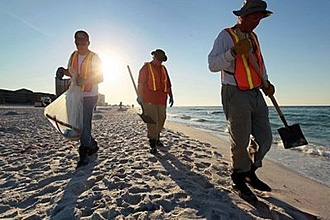
|  |  |  Americas & Beyond Americas & Beyond  
BP Looks to Relief Well to Finish Kill
 Matt Davis - Agence France-Presse Matt Davis - Agence France-Presse
go to original
August 06, 2010


| | Workers pick up oil residue on Pensacola Beach in the Gulf of Mexico. (AFP/Getty Images/Joe Raedle) |  |
New Orleans, Louisiana – With its runaway well in the Gulf of Mexico finally plugged with cement, BP turned Friday to a relief well to make sure that the source of the United States' worst environmental disaster is killed for good.

"This is not the end, but it will virtually assure us that there will be no chance of oil leaking into the environment," Thad Allen, in charge of the US response to the spill, said Thursday after BP's Macondo well was plugged.

"I think we can all breathe a little easier," he said.

One more step remains, though: to cut the well off from the bottom with a relief well and entomb it in mud and cement as an additional precaution.

BP said mid-August is the most likely date that the first of two relief wells being drilled will intercept the Macondo well. The second relief well is a backup that was drilled in case of a problem with the first one.

Officials caution that the long-term impact of the disaster could be felt for years, even decades.

But the massive oil slick that once stretched for hundreds of miles is rapidly disappearing from the Gulf, some 15 weeks after the well ruptured and 21 days after the flow was fully stemmed with a temporary cap.

On Wednesday, BP brought the well under control, pumping heavy drilling fluid into it for eight hours until the oil was pushed back down into the reservoir miles beneath the seabed.

The British energy giant then began pumping cement early Thursday and the "static kill" operation was completed in five hours.

It took 106 days to shut the well down in the wake of a devastating explosion on April 20 that killed 11 workers and sank the BP-leased Deepwater Horizon rig two days later, unleashing a torrent of oil into the Gulf.

At 4.9 million barrels - or enough oil to fill 311 Olympic-sized swimming pools - the disaster is the biggest maritime spill on record.

Heavy brown oil coated fragile coastal wetlands, sullied sandy white beaches, and smothered thousands of birds, turtles, dolphins and other marine life.

The disaster crippled the Gulf's multibillion dollar commercial and recreational fishing industry and plunged residents of coastal communities into months of anguish over their livelihoods and the region's future.

A government report released Wednesday found that a third of the oil was captured or mitigated through burning, skimming, chemical dispersion and direct recovery from the wellhead.

Another twenty percent or so was "completely removed" from the system through natural processes as waves and currents broke the slick up into smaller patches and the warm waters helped speed biodegradation and evaporation.

"Most of the remainder is degrading rapidly, or is being removed from the beaches," Jane Lubchenco, head of the National Oceanic and Atmospheric Administration, told a White House briefing.

But fishermen worried about what they'll find when they are finally allowed back out on the water with their boats, and whether consumers will be willing to eat what they catch.

And with tourists likely to avoid Gulf beaches for years and oil industry jobs under threat from President Barack Obama's moratorium on new deep sea drilling permits, the future remains bleak for many coastal communities.

"It's impossible to know how this thing is ultimately going to play out," said Matt O'Brian, owner of a shrimp and crab processing dock in the coastal town of Venice, Louisiana.

O'Brian welcomed the news that the well was finally under control, but said it "can't overcome the atmosphere of uncertainty lingering out at sea."

He's worried about the oil's impact on crab and shrimp populations and wonders if there will ever be a market for Louisiana seafood.

Todd Goodman, who works for the local government and runs a trailer park as a sideline, agreed.

"There is enormous pressure on BP to claim that everything is fine now. But what scares me and a lot of other folks around here is the notion that everybody - BP, the Coast Guard, law enforcement, cleanup crews - will suddenly pull up stakes and leave," he said.
|

 |
|  |



